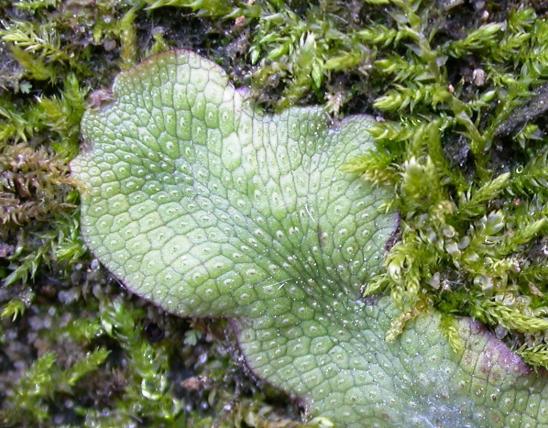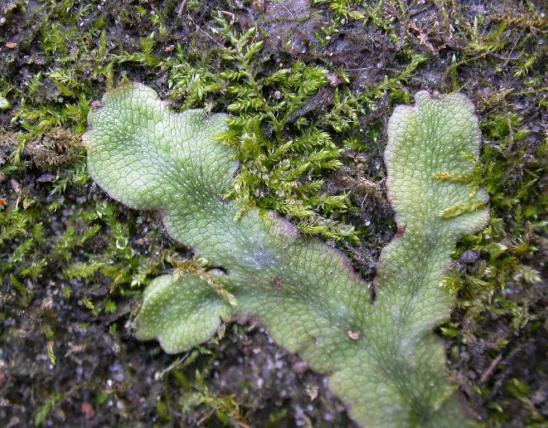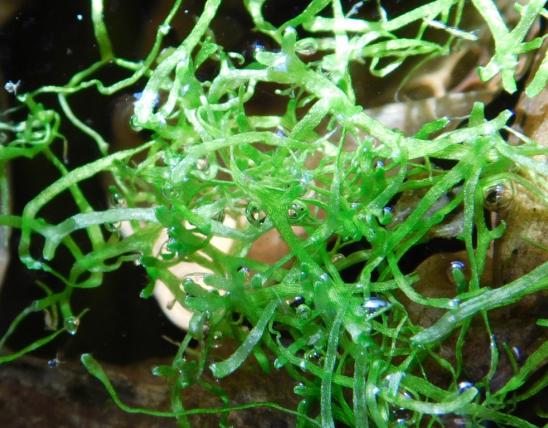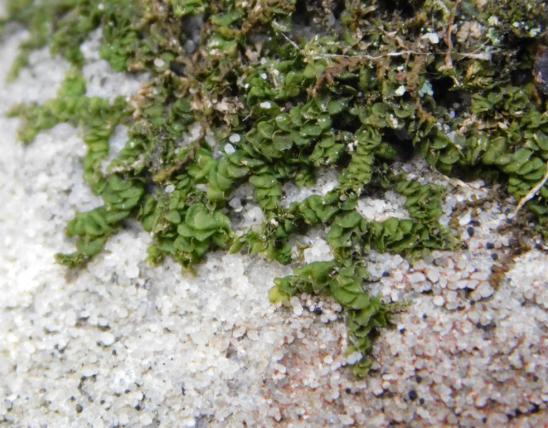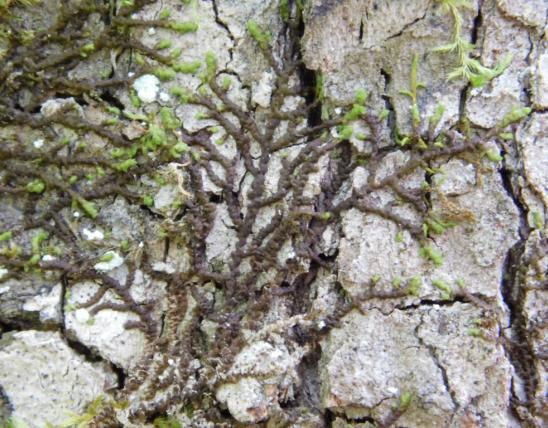
Umbrella liverwort is a common thallose liverwort. It is well-known globally. It grows in green ribbons and is very common on the moist soil of potted plants. It typically forms cuplike gemmae on its upper surface. Its palm-tree-shaped archegona are distinctive, too.
Umbrella liverwort is similar to another very common liverwort, snakeskin liverwort, Conocephalum salebrosum (formerly called C. conicum in North America), but in umbrella liverwort has the following key ID characters:
- The thallus (leaflike vegetative body) turns up at the edges.
- The netlike pattern on the upper surface of the thallus is less deeply indented and less noticeable than in snakeskin liverwort.
- Umbrella liverwort commonly has cuplike gemmae on the upper surface (it is our only native North American thallose liverwort to form gemmae cups).
- The antheridia are stalked, with a flat, circular top with lobed or deeply scalloped edges (not sessile and wartlike).
- The archegonia, at first, look like small mushrooms, but at maturity they open to produce fingerlike projections radiating from the central stalk (looking like tiny palm trees).
Thallose, or thalloid liverworts are the types of liverworts most people are familiar with. They look like green ribbons or scales that grow flat against a surface. This part of the plant is called the thallus. If the thallus branches, it does so in a Y-shaped pattern. There are no clearly defined stems or leaves. In some species, the surface may be patterned like snakeskin.
Liverworts, like mosses, are land plants that do not have a vascular system. Their lack of veinlike tubes to conduct moisture and nutrients throughout the plant limits them to a small size. They produce spores instead of seeds. Their form of reproduction usually requires them to be in wet or moist places. Learn more about liverworts on their group page.
Similar species: Missouri has several other species of thallose liverworts. This is one of the most common and widespread species.
Length: a thallus can be up to about 2 inches long; width to about ¾ inch. Can form large colonies along streams or in greenhouses.
Statewide.
Habitat and Conservation
In addition to damp, shady areas in nature, umbrella liverwort is also fairly common in gardens and greenhouses. It is sometimes considered a weed in greenhouses.
Status
This liverwort is common and widely distributed globally. It is the only member of its family.
Researchers have generally identified three subspecies (globally) of this liverwort. In the past, these were considered separate species. Currently, genetic studies are ongoing to help understand how these plants have diverged from each other.
Life Cycle
The liverworts we usually see are only one part of a two-part life cycle. This conspicuous part of the cycle, called the gametophyte (gamete-bearing plant), produces sexual reproductive structures: sperm-bearing male structures called antheridia (singular antheridium) and egg-bearing female structures called archegonia (singular archegonium).
In umbrella liverwort, the antheridia and archegonia occur on separate plants: the antheridia are stalked, with a flat, circular top with lobed or deeply scalloped edges, and the archegonia start out looking like small mushrooms, but at maturity they open to produce fingerlike projections radiating from the central stalk (looking like tiny palm trees).
The united sperm and egg develop into the second part of the life cycle, the sporophyte (spore-producing plant). The sporophyte develops within the archegonium and eventually pushes beyond it. The sporophyte develops a capsule in which spores form. When the sporophyte is mature, it sheds spores into the environment that develop into new gametophytes.
Asexual (vegetative) reproduction is very common in liverworts. As the gametophyte grows and branches, older parts die off and the branches continue as new plants. They can easily grow by cuttings, too. Floods can distribute fragments of liverworts downstream, creating new colonies. In greenhouses, small fragments of umbrella liverwort easily get moved around in potting soil and colonize the top surface of the soil.
The gemmae cups common in umbrella liverwort are another form of asexual reproduction. Gemmae are basically tiny buds of the parent plant that separate to become new plants. In umbrella liverwort, the gemmae look like tiny leaves inside the cup. When rain strikes the gemmae cups, it splashes the gemmae away to begin new plants.
Human Connections
In greenhouses and gardens, umbrella liverwort is often associated with silvergreen bryum moss (Bryum argenteum), a tiny moss species that also thrives in potting soil and easily spreads to new locations via horticultural distribution. Both are sometimes viewed as horticultural weeds.
Because umbrella liverwort is widespread and common all over the world, it is the one that usually appears in science classrooms as (literally) the textbook liverwort. It helps that the antheridia, archegonia, and gemmae structures all have different forms in this species and are large enough to see without magnification.
Because it can tolerate the presence of lead and other heavy metals in soils, umbrella liverwort may be helpful for restoring habitats that have been damaged due to mining and other disruptions. Researchers have noted that a dense concentration of umbrella liverwort, combined with a lack of other plants, may indicate that an area may be polluted with lead or other heavy metals.
This globally common species is no doubt one of the liverworts that was once used medicinally and gave the group its name. The common names “liverwort” and “hepatic” both refer to an antique belief that this group of plants could be used to treat liver ailments. This was based on an idea called the Doctrine of Signatures, which started in Classical Greek and Roman days and continued in Europe into the 1600s. The idea was that God had marked everything on earth with a sign (signature) that gives a hint to its purpose for humanity; therefore, if something resembled a lung, it could be used to heal lungs, and certain types of thallose liverworts, which supposedly look like a liver, could treat liver problems. In the 1700s, the rise of humanism and the scientific method helped arrest this unsound medical reasoning.
Ecosystem Connections
Umbrella liverwort plays an important role in healing a landscape after a fire. In some areas, it is often one of the first plant species to begin growing on the exposed soil. Thus it prevents erosion, starts building up the soil’s organic content, and begins the stages of plant succession. Over time, successively larger and more specialized plants take root and survive, ultimately renewing the habit. After a few years, the umbrella liverwort can’t compete with its successors and dies out in that habitat.
Liverworts, mosses and other small, low plants form a microhabitat where many types of insects and other invertebrates live. Earthworms, centipedes, sowbugs, springtails, snails, and a wide variety of other small animals live in and around these low humble plants. Tartigrades, or water bears, are curious microscopic eight-legged animals that often live among bryophytes. Shrews, salamanders, frogs, tiny snakes, and other insectivores hunt for a variety of small animals in these microhabitats.




Mosses, liverworts, hornworts, and lichens seem rather similar, but these organisms are in very different groups. Mosses, liverworts, and hornworts are small, low plants usually found in damp habitats. Unlike more familiar plants, they lack veinlike structures and do not produce flowers or seeds — instead, they produce spores. Meanwhile, lichens are not plants at all: they are a collection of different fungi that have photosynthetic algae living within their tissues.






















